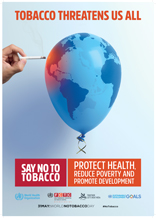Key facts
- Tobacco kills up to half of its users.
- Tobacco use and exposure remain the cause of 6 million preventable deaths per year globally , accounting for 6% of all female and 12% of all male deaths in the world. More than 5 million of those deaths are the result of direct tobacco use while more than 600 000 are the result of non-smokers being exposed to secondhand smoke
- 80% of the world’s one billion smokers live in low- and middle-income countries.
- The scourge of tobacco use is entirely preventable.
Tobacco epidemic in the Western Pacific Region
- Of the World Health Organization’s six regions, the Western Pacific Region has:
- the greatest number of smokers
- the highest rates of adult smoking prevalence
- the greatest number of smoking-related deaths for both sexes
- One third of the cigarettes consumed globally are smoked in the Region.
- Approximately three people die every minute due to tobacco-related diseases in the Region.
- 13% of all deaths are attributable to tobacco in the Region. One in ten premature deaths of people aged 30-60 years old is also attributable to tobacco use.
- The Region is one of the fastest growing markets for tobacco products, but the tobacco epidemic could hamper long-term economic growth and development in the Region. For example, premature deaths from noncommunicable diseases that can result from tobacco use eventually equate to a loss of productivity.
- The smoking prevalence in low-income groups is approximately 50% higher than in higher income ones in the Region.
- The prevalence of adults smoking is expected to decrease by only 2.4% in 2015 — with a projected 3.9 M people still smoking by 2025 in the Region alone.
- 8.2% of students in the Region use tobacco products, and more than 1 million of students currently smoke cigarettes.
- Nearly 20 percent of people who have never smoked are susceptible to start smoking within the next year in the Region. Interestingly, 74.9% of smoking students in the Western Pacific Region desire to quit , making up the largest percentage of students desiring to quit smoking compared to all other regions.
- For most countries in the Region, the average rate of early initiation of smoking (below the age of 10) is more than 10% and can be as high as 38% in some countries.
Second-hand smoke kills
- Worldwide, 40% of children are exposed to secondhand smoke. In the Western Pacific Region, the percentage of students’ exposure to secondhand smoke is 44.1% at home, 47-67% in enclosed public places, and 44-66% in school.
- The Western Pacific Region is one of the regions with the highest prevalence of secondhand smoke exposure to non-smokers.
- Secondhand smoke contains over 7000 chemicals of which at least 69 are known carcinogens.
- Secondhand smoke exposure to tobacco causes 600,000 estimated deaths per year globally , specifically over 100,000 in the Western Pacific Region alone.
Tobacco’s toll on human life
- Tobacco use is the second biggest contributor to the epidemic of noncommunicable disease, next to high blood pressure.
- No consumer product kills as many people, and as needlessly, as does tobacco. It killed 100 million people in the 20th century. Unless we act, the death toll can reach 1 billion people in the 21st century.
- Tobacco is responsible for over 71% of all cases of lung cancer deaths globally, 42% of chronic respiratory disease deaths, and nearly 10% of all deaths from cardiovascular disease.
- Smokers are more susceptible to certain communicable diseases, such as tuberculosis and lower respiratory infections.
- Tobacco use is a major risk factor for six of the eight leading causes of mortality in the world.
The poor are most harmed
- Tobacco use is growing fastest in low- and middle-income countries, owing to steady population growth and tobacco industry targeting . By 2030, more than 80% of the world’s tobacco-related deaths will occur in these countries.
- Tobacco use can inflict immediate harm on users and their families when scarce family resources are spent on tobacco products instead of other basic and essential needs. Even a small diversion of the resources of poor families who live at or are below the edge of poverty can have a significant impact on their health and nutrition.
- The costs related to tobacco use are significant. Most tobacco-related deaths occur among working-age adults. Those who do not succumb immediately often face prolonged disability. In low-income countries, where health insurance is scarce or non-existent, direct health-care costs are frequently borne entirely by families.
- The economic impact of early death, disability and lost productivity contributes to the burden of poverty, retarding national development and further widening health inequities. This is especially true in low- and middle-income countries, where resources for tobacco control are often limited. Therefore, tobacco control is not only a public health priority, but also a key development issue.
Use international law as the basis for national regulation of tobacco
- In the past, traditional public health methods for reducing tobacco use such as individual interventions by health professionals were no match for the tobacco industry’s power, transnational reach, formidable resources and active promotion of tobacco use. Today we put a lot of our efforts on policy regulation to combat the epidemic.
- The most powerful tool in combatting this scourge is the WHO Framework Convention on Tobacco Control (WHO FCTC). It is the first international treaty negotiated under the auspices of the World Health Organization to reduce the health and economic burden of tobacco use. The WHO FCTC has 180 parties and all Member States in the Western Pacific Region are Parties to the Convention.
- WHO FCTC was developed in response to globalization of the tobacco epidemic and represents a new approach in international health cooperation, using a global legal framework to address a globalized epidemic. The WHO FCTC contains both demand- and supply-reduction measures.
- In 2008, WHO introduced a practical, cost-effective way to scale up implementation of provisions of the WHO Framework Convention on the ground: MPOWER. Each MPOWER measure corresponds to at least one provision of the WHO Framework Convention on Tobacco Control.
The six MPOWER measures are:- Monitor tobacco use and prevention policies
- Protect people from tobacco use
- Offer help to quit tobacco use
- Warn about the dangers of tobacco
- Enforce bans on tobacco advertising, promotion and sponsorship
- Raise taxes on tobacco
- The key is full implementation of the WHO FCTC – governments must enact and enforce national laws that are consistent with the provisions of the treaty. Full implementation of the WHO FCTC will save millions of lives of people who would otherwise die prematurely in their productive years . It will also save billions of dollars that would otherwise be lost through medical expenditures on tobacco–related disease and/or losses in productivity of workers.
- The biggest barrier to enactment and enforcement of national laws that are consistent with the WHO FCTC is interference of the tobacco industry in public health policy. Vigilance and concerted action by governments, civil society and communities are needed to stop this and enable full implementation of the treaty
Ref:
http://www.wpro.who.int/mediacentre/factsheets/fs_201203_tobacco/en/
World No Tobacco Day

